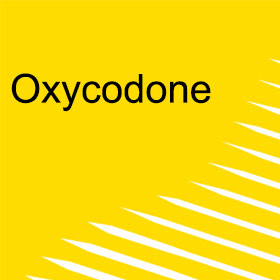
Oxycodone
hillbilly heroin, oxy, OC, O, Oxynorm®, OxyContin®, Endone®, Proladone®, Targin®
What is oxycodone?
Oxycodone is a pharmaceutical opioid commonly used for the management of pain.
Opioids are depressant drugs, which slow down the activity of the central nervous system and messages going between the brain and the body.
Oxycodone can only be obtained with a doctor’s prescription. Non-medical use of pharmaceutical opioid medications refers to use that occurs outside a doctor’s prescription and is illegal on many countries including Australia.
Oxycodone is usually taken orally, but is sometimes injected or used as a suppository (ADF, 2020).
What are the effects?
- Pain relief
- Dizziness or faintness
- Tiredness
- Confusion and difficulty concentrating
- Euphoria or negative mood
- Restlessness
- Stiff muscles
- Constipation
- Dry mouth
- Stomachache and nausea
- Difficulty urinating
- Slow pulse
- Excess sweating, flushing and itching
- Mild allergic rash or hives (ADF, 2020)
What are the risks?
Regular use of oxycodone may cause:
- Dental problems
- Mood swings
- Reduced sex drive and decreased level of testosterone (males) and menstrual problems (females)
- Needing to use more to get the same effect
- Financial, work or social problems (ADF, 2020)
If oxycodone is injected, additional risks include:
- Harms from injecting tablet particles that can lodge in blood vessels and small capillaries in the lungs
- Risks of blood-borne viral infections (BBVIs) if injection equipment is shared
- Harms related to injection of non-sterile preparations not intended for injection
- Harm related to pre-existing conditions for which opioids may be contraindicated
Mixing oxycodone with other drugs
The effects of taking oxycodone with other drugs − including over-the-counter or prescribed medications − can be unpredictable.
Mixing oxycodone and alcohol could lead to increased confusion, clumsiness and breathing difficulties (ADF, 2020).
Toxicity and overdose
Like any other opioid, it is possible to overdose on oxycodone, which may be fatal. The signs of overdose include:
- Extreme drowsiness or the person may even be impossible to wake (‘on the nod’)
- Unresponsive to verbal approach
- Small (‘pinned’) pupils
- Slowed breathing and heart rate (down to four breaths per minute)
- Total respiratory failure
- Snoring
- Blue or purple coloured skin (cyanosis), usually starting on lips and fingers
- Low blood pressure
- A drop of body temperature to below 35 degrees (hypothermia) (Darke, Lappin & Farrell, 2019)
If caught in time, the effects of overdose can be reversed by the administration of naloxone.
When medications are used outside the guidelines for safe and effective use, adverse effects may be more likely.
Dependence and withdrawal
As oxycodone is an opioid, it has high levels of dependence and withdrawal. This may be a problem if the drug is used over a long period of time.
Usually, withdrawal begins one to three days after the last dose. Symptoms may include:
- Uneasiness/anxiety
- Yawning
- Diarrhoea
- Stomach cramps
- Runny nose
- Sleeping difficulties
- Joint pain
These symptoms generally peak around the sixth day, but some may last for several weeks.
Other harmful use practices that may lead to dependence:
- Excess prescriptions
- Long-term use (more than three months)
- Rapid dose escalations
- Extra-medical use
- Use with other drugs – tricyclic antidepressants, antipsychotics and pregabalin (Darke, Lappin & Farrell, 2019)
How many people use oxycodone?
According to the Australian Institute of Health and Welfare, in 2019, 30.3 percent of people aged 14 and over who used painkillers/pain relievers and opioids for non-medical purposes in the previous 12 months, reported using oxycodone (AIHW, 2020).
Treatment
Treatment for oxycodone dependence differs depending on severity of the addiction, and a range of other factors.
Some treatments include taking opioid agonist treatment like buprenorphine or methadone. This pharmacotherapy helps stabilise people with an opioid dependence and reduce harms related to opioid use.
Other treatments include behavioural therapy in an inpatient or outpatient setting, cognitive behavioural therapy, specialised treatment programs, and recovery groups.
Emergency info
If you, or someone around you, is experiencing undesired or distressing psychological or physical symptoms from the intake of alcohol or other drugs please seek immediate medical attention.
If you need urgent help from ambulance services call Triple Zero (000). If a person has been mixing drugs with alcohol or other drugs, tell the paramedic exactly what has been taken.
Services
For free and confidential advice about alcohol and other drugs, call the National Alcohol and Other Drug hotline on 1800 250 015.
The hotline will automatically direct you to the Alcohol and Drug Information Service in your state or territory.
More resources
The Illicit Drug Reporting System is an Australian monitoring system that identifies emerging trends of local and national interest in illicit drug markets.
The Ecstasy and Related Drugs Reporting System is an Australian monitoring system for ecstasy and related drugs that identifies emerging trends of local and national interest.
The Clinician’s Guide to Illicit Drugs and Health examines the health effects of each of the major illicit drugs.
The Australian Institute of Health and Welfare collects information on alcohol and tobacco consumption, and illicit drug use among the general population in Australia.
The Australian Bureau of Statistics is Australia’s national statistical agency, providing official statistics on a range of economic, social, population and environmental matters of importance to Australia.
Sources
Alcohol and Drug Foundation (2020). Oxycodone. Retrieved from https://adf.org.au/drug-facts/oxycodone/
Australian Institute of Health and Welfare (2020). Australian National Drug Strategy Household Survey 2019. Retrieved from https://www.aihw.gov.au/reports/illicit-use-of-drugs/national-drug-strategy-household-survey-2019/contents/table-of-contents
Darke, S., Lappin, J., & Farrell, M. (2019). The Clinician’s Guide to Illicit Drugs and Health, Great Britain: Silverback Publishing.
Resources
Fact sheets
- Overview
- News
- Our team
- References




